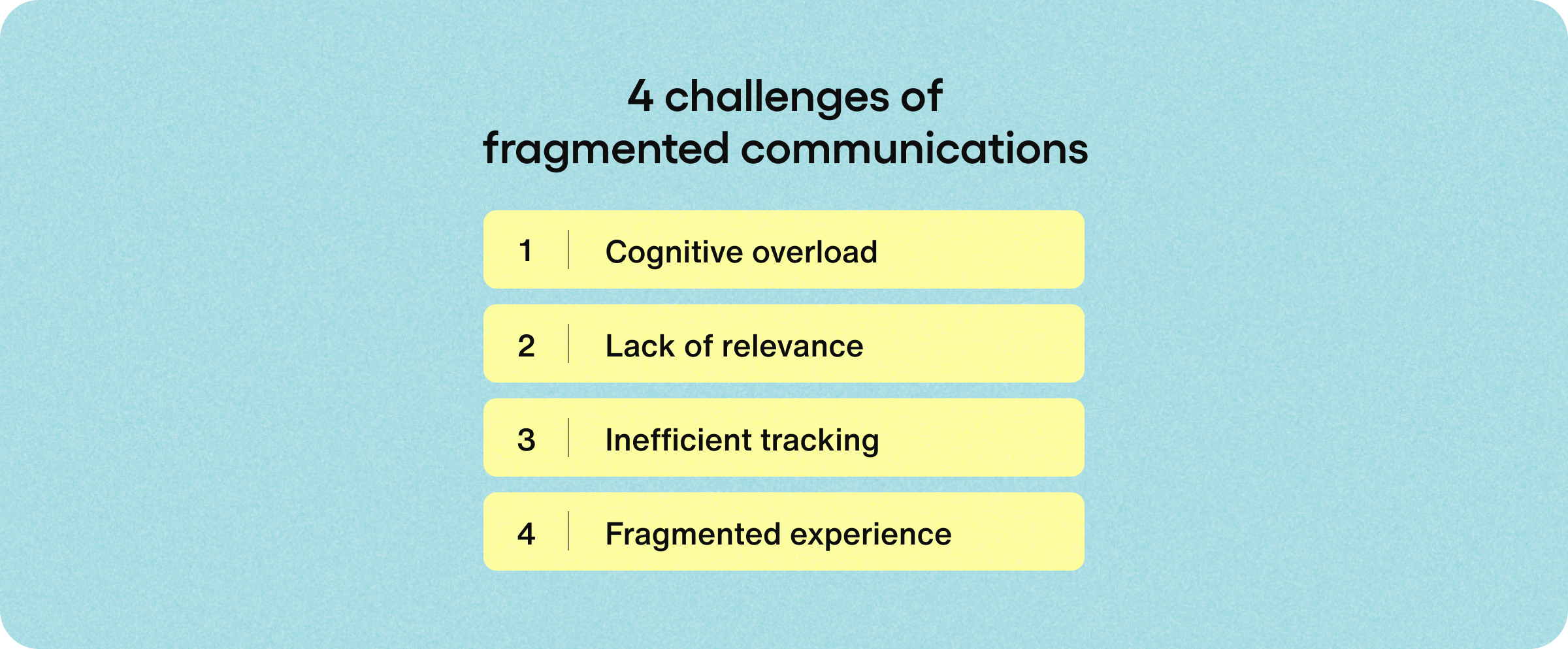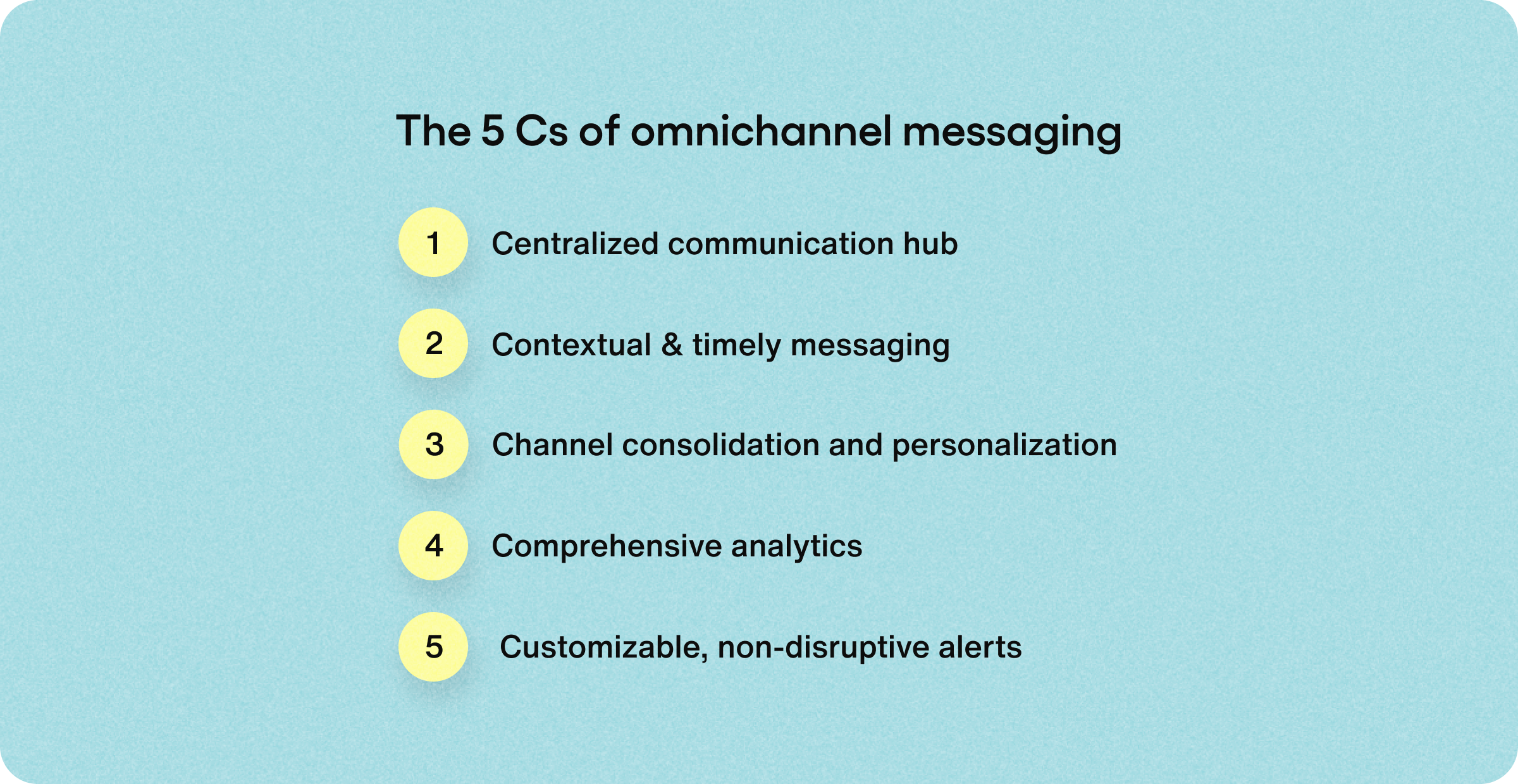The 5 Cs of omnichannel messaging: Unified business messaging for on-demand platforms

Effective business messaging with your workers' network is critical to drive successful change management in the on-demand economy. This is partly because platforms that rely on gig workers to fulfill orders, take on temporary jobs, or provide customer services, face unique challenges in keeping their workforce informed and engaged.
For example, every piece of communication (such as a push notification, in-app message, WhatsApp message, or SMS) about a product update, a process change, or essential safety information, can directly impact a worker’s ability to do their job effectively. A traffic alert, for instance, may advise a rideshare driver to avoid certain routes.
However, many on-demand platforms are plagued by a common problem: fragmented communication channels. The result is a chaotic and inconsistent experience for gig workers who are left to figure out where crucial information is located, often leading to confusion, missed updates, and lost productivity.
The challenge: Fragmented communication overloads gig workers

Consider an on-demand grocery service that needs to communicate with its delivery workers about product inventory updates, new check-in/out procedures, weather alerts, and partner changes. Their communication approach is often fragmented and ineffective, relying on multiple external channels, such as emails, Facebook groups, push notifications, and SMS, which are not native to the platform.
This can be problematic because:
Emails aren’t read systematically.
Facebook is not a digital space for work activities; it is used instead for social conversations.
SMS, as the default communication option, can be plagued with delivery issues related to carrier filtering.
Shoppers are overwhelmed by the sheer volume of everyday communications, sometimes receiving tens of push notifications daily.
Discover the unexpected costs of SMS & the savings of omnichannel messaging
While each channel serves a clear purpose, the lack of a unified strategy can cause chaos for gig workers. The lack of clear guidance on where they can find essential information results in several key problems.

Cognitive overload: Gig workers are forced to recall which channel hosts what type of information (e.g., a pay update vs. a new product feature), leading to confusion and missed messages.
Lack of relevance: Messages are sent through channels that aren’t aligned with workers' preferences or timed correctly, causing even critical messages to be ignored or forgotten.
Inefficient tracking: Platforms struggle to track how many workers actually see their messages and cannot measure the effectiveness of each communication channel, leading to uncertainty about the impact of communications.
Fragmented experience: With no central message hub for communication, gig workers feel disconnected from the platform. They often need to hunt through different channels to find relevant updates, whether they’re on the clock or not.
In a business where the success of gig workers is tightly linked to platform success, these communication issues are more than just operational hurdles—they are threats to worker satisfaction, retention, and overall productivity.
The solution: A unified, worker-centric communication approach via omnichannel messaging
To overcome these challenges, on-demand platforms need more than just a communication tool; they need an omnichannel messaging solution that integrates seamlessly with their platform’s workflow and provides workers with clear, concise, and timely information.
Here are the key capabilities that omnichannel messaging provides to solve the problem of fragmented communication.

Boost ops efficiency and revenue + save big with omnichannel messaging
The 5 Cs of omnichannel messaging

Centralized communication hub: Gig workers need a single, unified place within their platform to access all critical communications. Whether it’s a weather alert, a new app feature, or a change of delivery schedule, they should be able to easily retrieve information without needing to remember which channel it came through.
Channel consolidation and personalization: Instead of sending a flood of messages across many channels, platforms need to send fewer messages to targeted recipients. Businesses can do this by understanding which channels are more efficient and using the others only as a fallback.
Contextual and timely messaging: Communications should be delivered in a way that aligns with the worker’s context and needs. For example, a notification about a change in a restaurant pickup should arrive in the app in an alert section as the gig worker takes on the job, not by SMS during off-hours when they’re not engaged with the platform.
Customizable, non-disruptive alerts: While urgent alerts need to stand out, they shouldn’t disrupt the worker’s flow; this is a fine balance to achieve. Notifications should be customizable to fit the design of the app and be delivered in a way that doesn’t interfere with the user experience, particularly during critical tasks like completing an order for an on-demand service.
Comprehensive analytics: Platforms need robust analytics to track the effectiveness of their communications. This includes insights into which messages were opened, read, and acted upon, as well as a clear view of the communication history at the individual level.

How to build the perfect mix of mobile customer communication channels
How Sendbird Business Messaging unifies and streamlines communication

Sendbird solves these notification challenges by providing an in-app first, omnichannel business messaging platform that consolidates all messaging into a unified experience for gig workers. Here’s how:
Usable easily by all teams: Empower Product, Operations, Support, and Engineering teams with software and an API to message customers through an in-app message center, SMS, mobile push, and WhatsApp.
In-app message center: Sendbird provides a message center directly within the app, where workers can find all communications, whether they are schedule changes, product updates, or safety alerts. This reduces the cognitive load on workers, who no longer need to sift through external channels like emails, push notifications, or Facebook groups.
Reduced noise with targeted notifications: By selecting the right audience and sending in-app and push notifications first before falling back to WhatsApp and/or SMS, Sendbird allows on-demand platforms to reduce the number of messages while increasing their impact in change management situations. Instead of overwhelming workers with a daily flood of messages, gig workers receive personalized notifications tailored to their needs and preferred communication channels.
Detailed communication insights: With Sendbird, platforms can track the effectiveness of their communications with detailed in-app notification analytics. This includes delivery rates, read rates, open rates, and user behavior after receiving messages. These insights allow platforms to continuously optimize their communication strategy and ensure critical information is seen and acted upon.
Customizable and non-disruptive design: Sendbird’s in-app message center is highly customizable with iOS, Android, JS, and Flutter notifications SDKs, ensuring that communications don’t interfere with the user experience. Notifications can be styled to fit seamlessly into the platform, and critical messages are presented in a way that catches attention without disrupting the flow of work.
With Sendbird Business Messaging, on-demand platforms in the gig economy can eliminate fragmented communication, streamline operations, and enhance their workers’ communication experience.
Businesses can go a step further with Sendbird by adding chat messaging, calls, and AI chatbots to augment direct notifications with conversational interactions, further driving engagement, productivity, and overall platform success.

Boost ops efficiency and revenue + save big with omnichannel messaging
Elevate the gig workers’ communication experience with omnichannel business messaging
Many on-demand platforms face the challenge of keeping their workers informed in a fast-paced, multi-channel environment. By adopting an in-app-first, omnichannel notification platform like Sendbird, businesses can eliminate the chaos of fragmented communication, deliver more targeted and relevant messages, and ultimately create an exceptional experience for their gig workers. The result is a more engaged, productive, and satisfied workforce that aligns with the on-demand platform’s goals.
If you’re ready to elevate the communication experience of gig economy workers, you can start sending omnichannel business messages today or contact us to learn more.










